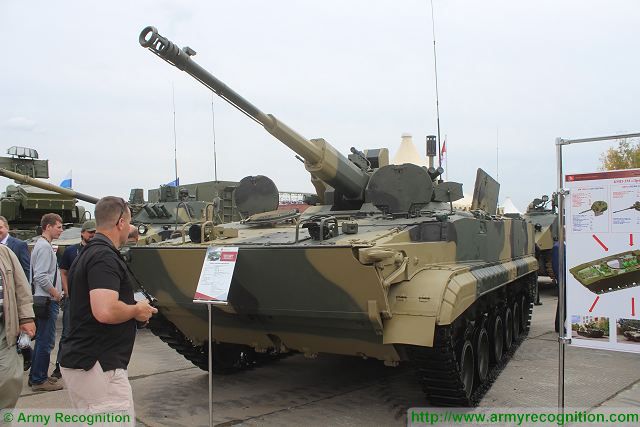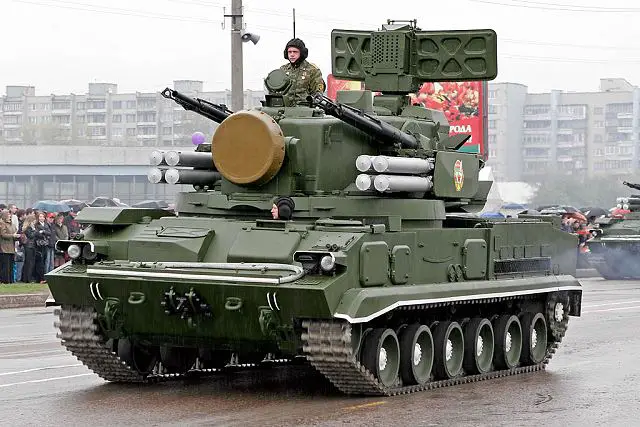|
|
|||
|
Defence & Security News - Russia
|
|||
|
|
|||
| Russia would like to replace anti-aircraft systems ZSU-23-4 & Tungunska with new 57mm weapon. | |||
|
Commander of the Russian Land Force’s air defense stated that Russia is developing a new 57 mm caliber anti-aircraft weapon system to replace two anti-aircraft existing systems, the ZSU-23-4 Shilka and the 2K22 "Tunguska" (NATO code 2S6).
|
|||
|
|
|||
 BMP-3 Dragoon fitted with a remotely weapon station armed with one 57mm automatic cannon. BMP-3 Dragoon fitted with a remotely weapon station armed with one 57mm automatic cannon. |
|||
|
|
|||
|
Russian defense industry is developing a new 57 caliber anti-aircraft weapon system to replace two short-range defense systems armed with cannons, the commander of the Russian Land Force’s air defense said.
"A promising new anti-aircraft artillery system with a caliber of 57 mm is being developed to replace ‘Tunguska’ and ‘Shilka’ systems," Lt. Gen. Alexander Leonov told reporters late Thursday. During the Defense Exhibition RAE 2015 (Russia Arms Expo) in September 2015, the Russian defense industry has presented a new vehicle under the name of "Dragoon" based on the chassis of BMP-3 infantry fighting vehicle fitted with a new turret armed with a 57mm automatic cannon using gun mount module AU-220M. A 7,62mm coaxial machine gun is mounted to right side of the main armament. A bank of four smoke grenade dischargers is mounted on each side of the turret. The AU-220M gun mount system is a remotely operated unmanned turret design to be easily integrated onto modern light infantry fighting vehicles. The ZSU-23-4 "Shilka" is a Russian lightly armoured, self-propelled, radar guided anti-aircraft weapon system (SPAAG). The ZSU-23-4 Shilka was developed in the early 1960's and was first seen in public during a parade in Moscow in November 1965. The main armament is composed with four AZP-23 23 mm cannons with an elevation of +85° to - 4°, and 36° turret traverse. The 23 mm cannon is gas operated with a vertically moving breech-block locking system which drops to unlock, and has a cyclic rate of fire of 800 to 1000 rounds per minute per barrel. |
|||
|
|
|||
 Russian-made ZSU-23-4 Shilka armed with four AZP-23 23 mm cannons Russian-made ZSU-23-4 Shilka armed with four AZP-23 23 mm cannons |
|||
|
|
|||
|
The 2S6 Tunguska 2K22 is a Russian-made self-propelled air defence system which combines gun and missile armament. The development of the 2S6 Tunguska began in 1970 after a request by the Russian army for a new self-propelled anti-aircraft weapon system to replace the old ZSU-23-4 self-propelled anti-aircraft gun.
The turret of 2S6M Tunguska is mounted in the center of the chassis and armed with two 30mm 2A38 twin cannons, one to each side of the turret. Mounted outwards and below the 30 mm cannon is a bank of four 9M311 SAMs (Surface-to-Air Missile) in two blocks of two, which can elevate vertically independently of each other. The 9M311 can engage aerial targets with altitudes between 15 and 3,500 m and from 2,400 to 8,000 m in slant range with the target having a maximum speed of 500 m/s. Russian sources quote the crossover range as being up to 4,000 m. |
|||
|
|
|||
 Russian-made 2S6 Tunguska 2K22 anti-aircraft vehicle with automatic cannons and missiles Russian-made 2S6 Tunguska 2K22 anti-aircraft vehicle with automatic cannons and missiles |
|||
Russia would like to replace anti-aircraft systems ZSU-23-4 & Tungunska with new 57mm weapon 12812151
- Posted On














